
They've all stood in the heart of Glasgow for at least 100 years, but now the city council has provoked controversy with a radical plan to remove the 12 statues in George Square.
HeraldScotland readers are already engaged in a heated online debate over the proposal, so we've prepared a handy guide to the statues of 11 men and one woman.
 The map shows the location of the 12 statues, with the City Chambers to the right (or east) of George Square, and the Scott statue at the centre, mounted on an 80ft column. Below are the 12 biographies, complete with close-up pictures taken today (complete with avian damage...)
The map shows the location of the 12 statues, with the City Chambers to the right (or east) of George Square, and the Scott statue at the centre, mounted on an 80ft column. Below are the 12 biographies, complete with close-up pictures taken today (complete with avian damage...)
 1. Thomas Graham: (B Listed, erected 1872 by William Brodie, cast by R Masefield and Son of Chelsea) Glasgow-born Graham (1805-1869) was a brilliant experimental chemist, who pioneered laboratory-based chemical education at Glasgow University. His studies on the diffusions of gases resulted in 'Graham's Law and his discovery of dialysis is still used in many medical facilities today. Graham founded the Chemical Society of London in 1841 and was the last person to hold the position of Master of the Mint.
1. Thomas Graham: (B Listed, erected 1872 by William Brodie, cast by R Masefield and Son of Chelsea) Glasgow-born Graham (1805-1869) was a brilliant experimental chemist, who pioneered laboratory-based chemical education at Glasgow University. His studies on the diffusions of gases resulted in 'Graham's Law and his discovery of dialysis is still used in many medical facilities today. Graham founded the Chemical Society of London in 1841 and was the last person to hold the position of Master of the Mint.
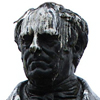 2. James Oswald: (B Listed, erected in 1856 by Marochetti) James Oswald of Auchincruive (1779 - 1853) was a liberal politician. He was a leading supporter of the movement that led to the Reform Act of 1832, and became one of the first Members of Parliament for Glasgow to be elected by male voting rights. In 1841 he succeeded to the family estate at Auchincruive, to which he retired after completing his second term in parliament. The monument was financed by private subscription from friends and admirers. It was originally erected in Sandyford Place in 1856 but was moved to a more prestigious site in 1875.
2. James Oswald: (B Listed, erected in 1856 by Marochetti) James Oswald of Auchincruive (1779 - 1853) was a liberal politician. He was a leading supporter of the movement that led to the Reform Act of 1832, and became one of the first Members of Parliament for Glasgow to be elected by male voting rights. In 1841 he succeeded to the family estate at Auchincruive, to which he retired after completing his second term in parliament. The monument was financed by private subscription from friends and admirers. It was originally erected in Sandyford Place in 1856 but was moved to a more prestigious site in 1875.
 3. Thomas Campbell: (B Listed, erected 1877 by John Mossman) Campbell (1777-1844) was a Scottish poet, historian and political commentator, born in Glasgow. His successful literary career began with the Pleasures of Hope, published in 1799, and other poems he composed include The Exile Of Erin, Ye Mariners of England and Soldier's Dream. In 1826 he was elected Lord Rectorship of Glasgow University, in competition against Sir Walter Scott. Campbell is buried in the Poet's Corner of Westminster Abbey.
3. Thomas Campbell: (B Listed, erected 1877 by John Mossman) Campbell (1777-1844) was a Scottish poet, historian and political commentator, born in Glasgow. His successful literary career began with the Pleasures of Hope, published in 1799, and other poems he composed include The Exile Of Erin, Ye Mariners of England and Soldier's Dream. In 1826 he was elected Lord Rectorship of Glasgow University, in competition against Sir Walter Scott. Campbell is buried in the Poet's Corner of Westminster Abbey.
 4. Field Marshall Lord Clyde: (B Listed, erected 1868 by JH Foley) Lord Clyde (1792-1863), educated at the High School of Glasgow, was a British Army officer who famously commanded the Thin Red Line of the 93rd Highlanders during the Crimean War, driving back the Russians at the Battle of Balaclava. He later became Commander-in Chief of the Indian Army and was nicknamed Old Careful because of his concern for the men under his command.
4. Field Marshall Lord Clyde: (B Listed, erected 1868 by JH Foley) Lord Clyde (1792-1863), educated at the High School of Glasgow, was a British Army officer who famously commanded the Thin Red Line of the 93rd Highlanders during the Crimean War, driving back the Russians at the Battle of Balaclava. He later became Commander-in Chief of the Indian Army and was nicknamed Old Careful because of his concern for the men under his command.
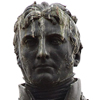 5. Sir John Moore: (A Listed, erected 1819 by John Flaxman) Moore (1761-1809) was a British army officer brought up in the Trongate, Glasgow. He began his military career at 15 and served as captain-lieutenant in the Duke of Hamilton's regiment in America. He rose through the military ranks and earned a reputation as one of the greatest trainers of infantrymen in military history. The effectiveness of his method was shown in the Peninsular War, where he was sent in 1808 to combat Napoleon. He defeated the French army at the Battle of Corunna in 1809, but was killed by a cannon shot.
5. Sir John Moore: (A Listed, erected 1819 by John Flaxman) Moore (1761-1809) was a British army officer brought up in the Trongate, Glasgow. He began his military career at 15 and served as captain-lieutenant in the Duke of Hamilton's regiment in America. He rose through the military ranks and earned a reputation as one of the greatest trainers of infantrymen in military history. The effectiveness of his method was shown in the Peninsular War, where he was sent in 1808 to combat Napoleon. He defeated the French army at the Battle of Corunna in 1809, but was killed by a cannon shot.
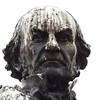 6. William Gladstone: (B Listed, erected 1902 by Hamo Thornycroft) Gladstone (1809 - 1898) served as Prime Minister four separate times during a political career lasting over 60 years. Despite beginning his career as a Tory and strict Anglican, he became Liberal Party leader in 1867 and was passionate about social reform. He tried unsuccessfully to secure Home Rule for Ireland during his career. He received the freedom of the City of Glasgow in 1865, and became Lord Rector of Glasgow University in 1879.
6. William Gladstone: (B Listed, erected 1902 by Hamo Thornycroft) Gladstone (1809 - 1898) served as Prime Minister four separate times during a political career lasting over 60 years. Despite beginning his career as a Tory and strict Anglican, he became Liberal Party leader in 1867 and was passionate about social reform. He tried unsuccessfully to secure Home Rule for Ireland during his career. He received the freedom of the City of Glasgow in 1865, and became Lord Rector of Glasgow University in 1879.
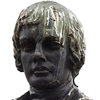 7. Robert Burns: (B Listed, erected 1877 by George Edwin Ewing, reliefs by J A Ewing, cast by Cox and Son) Scotland's national poet, Burns (1759-1796) wrote Auld Lang Syne, My Love Is Like A Red, Red Rose and Ode to a Haggis among many others. In this statue, Burns is shown as a superior Scottish peasant in frock-coat, waistcoat and knee breeches, holding a flower in his hand, and deep in poetic contemplation. In the late 19th century there was a movement to commemorate Burns with a series of statues, beginning with the Burns Monument in Kilmarnock in 1881.
7. Robert Burns: (B Listed, erected 1877 by George Edwin Ewing, reliefs by J A Ewing, cast by Cox and Son) Scotland's national poet, Burns (1759-1796) wrote Auld Lang Syne, My Love Is Like A Red, Red Rose and Ode to a Haggis among many others. In this statue, Burns is shown as a superior Scottish peasant in frock-coat, waistcoat and knee breeches, holding a flower in his hand, and deep in poetic contemplation. In the late 19th century there was a movement to commemorate Burns with a series of statues, beginning with the Burns Monument in Kilmarnock in 1881.
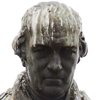 8. James Watt: (A Listed, erected 1832 by Chantrey) Watt (1736-1819) was a Scottish inventor and mechanical engineer, born in Greenock. He designed the first economical steam engine in 1769 and patented an improved version which had a separate condenser to reduce the consumption of fuel and steam. He came up with the idea of the condenser while walking on Glasgow Green one Sunday in 1765. The unit of electrical power was named in his honour in 1882. Watt and his sculptor Chantrey were close friends and this statue, one of several in Glasgow, was said to be a great likeness to Watt.
8. James Watt: (A Listed, erected 1832 by Chantrey) Watt (1736-1819) was a Scottish inventor and mechanical engineer, born in Greenock. He designed the first economical steam engine in 1769 and patented an improved version which had a separate condenser to reduce the consumption of fuel and steam. He came up with the idea of the condenser while walking on Glasgow Green one Sunday in 1765. The unit of electrical power was named in his honour in 1882. Watt and his sculptor Chantrey were close friends and this statue, one of several in Glasgow, was said to be a great likeness to Watt.
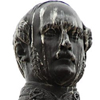 9. Prince Albert: (A Listed, erected 1866 by Baron Marochetti) Prince Albert (1819-1861) married Queen Victoria in 1840 and together they purchased the Balmoral estate in 1852. The statue was erected five years after his death. At the time, it was felt that an industrial city like Glasgow should commemorate a Prince who had been influential in social welfare and the advancement of industry. There was huge debate on what form the statue should take, but the Queen expressed a strong preference for the depiction of Albert on horseback, and she also suggested Marochetti be commissioned.
9. Prince Albert: (A Listed, erected 1866 by Baron Marochetti) Prince Albert (1819-1861) married Queen Victoria in 1840 and together they purchased the Balmoral estate in 1852. The statue was erected five years after his death. At the time, it was felt that an industrial city like Glasgow should commemorate a Prince who had been influential in social welfare and the advancement of industry. There was huge debate on what form the statue should take, but the Queen expressed a strong preference for the depiction of Albert on horseback, and she also suggested Marochetti be commissioned.
 10. Queen Victoria: (A Listed, erected in 1854 by Marochetti) Queen Victoria (1819-1901) succeeded to the throne in 1837 and first visited Glasgow in August 1849. Her great love of Scotland prompted the acquisition of Balmoral Castle as a royal residence, which she had rebuilt in 1856 and visited almost every year until her death. The monument shows the Queen seated side-saddle, holding an imperial sceptre raised in her right hand.
10. Queen Victoria: (A Listed, erected in 1854 by Marochetti) Queen Victoria (1819-1901) succeeded to the throne in 1837 and first visited Glasgow in August 1849. Her great love of Scotland prompted the acquisition of Balmoral Castle as a royal residence, which she had rebuilt in 1856 and visited almost every year until her death. The monument shows the Queen seated side-saddle, holding an imperial sceptre raised in her right hand.
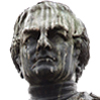 11. Sir Robert Peel: (B Listed, erected 1859 by John Mossman) Peel (1788-1850) was Prime Minister from 1834-35 and 1841-46. As Home Secretery he reformed the London police, introducing the concept of the Bobby and reformed criminal law. Not always having support from his own party, he proposed Catholic emancipation in 1829. In 1832, he became the leader of the Conservative Party. As PM he introduced financial measures to bring the country out of debt, and the last act of his government was the repeal of the Corn Laws.
11. Sir Robert Peel: (B Listed, erected 1859 by John Mossman) Peel (1788-1850) was Prime Minister from 1834-35 and 1841-46. As Home Secretery he reformed the London police, introducing the concept of the Bobby and reformed criminal law. Not always having support from his own party, he proposed Catholic emancipation in 1829. In 1832, he became the leader of the Conservative Party. As PM he introduced financial measures to bring the country out of debt, and the last act of his government was the repeal of the Corn Laws.
 12. Sir Walter Scott: (A Listed, erected 1837, column by David Rhind and statue by John Greenshields, carved by Handyside Ritchie) Scott (1771-1832), was an internationally acclaimed novelist and poet of works including Rob Roy and the Lady of the Lake. He was the first English-language author to have many contemporary readers in Europe, Australia and North America. Glasgow's was the first public monument to Sir Walter Scott anywhere in the world, 10 years ahead of the completion of Edinburgh's Scott Monument on Princes Street.
12. Sir Walter Scott: (A Listed, erected 1837, column by David Rhind and statue by John Greenshields, carved by Handyside Ritchie) Scott (1771-1832), was an internationally acclaimed novelist and poet of works including Rob Roy and the Lady of the Lake. He was the first English-language author to have many contemporary readers in Europe, Australia and North America. Glasgow's was the first public monument to Sir Walter Scott anywhere in the world, 10 years ahead of the completion of Edinburgh's Scott Monument on Princes Street.


Why are you making commenting on The Herald only available to subscribers?
It should have been a safe space for informed debate, somewhere for readers to discuss issues around the biggest stories of the day, but all too often the below the line comments on most websites have become bogged down by off-topic discussions and abuse.
heraldscotland.com is tackling this problem by allowing only subscribers to comment.
We are doing this to improve the experience for our loyal readers and we believe it will reduce the ability of trolls and troublemakers, who occasionally find their way onto our site, to abuse our journalists and readers. We also hope it will help the comments section fulfil its promise as a part of Scotland's conversation with itself.
We are lucky at The Herald. We are read by an informed, educated readership who can add their knowledge and insights to our stories.
That is invaluable.
We are making the subscriber-only change to support our valued readers, who tell us they don't want the site cluttered up with irrelevant comments, untruths and abuse.
In the past, the journalist’s job was to collect and distribute information to the audience. Technology means that readers can shape a discussion. We look forward to hearing from you on heraldscotland.com
Comments & Moderation
Readers’ comments: You are personally liable for the content of any comments you upload to this website, so please act responsibly. We do not pre-moderate or monitor readers’ comments appearing on our websites, but we do post-moderate in response to complaints we receive or otherwise when a potential problem comes to our attention. You can make a complaint by using the ‘report this post’ link . We may then apply our discretion under the user terms to amend or delete comments.
Post moderation is undertaken full-time 9am-6pm on weekdays, and on a part-time basis outwith those hours.
Read the rules hereComments are closed on this article